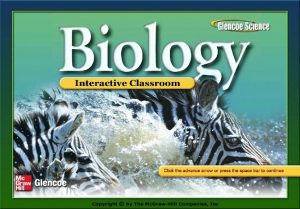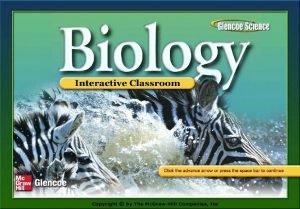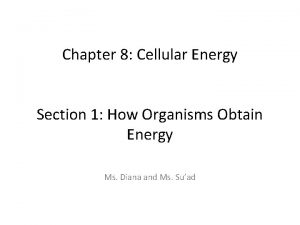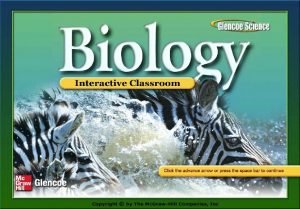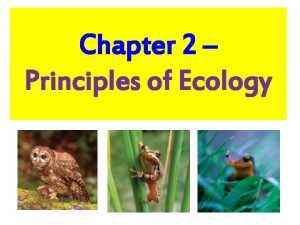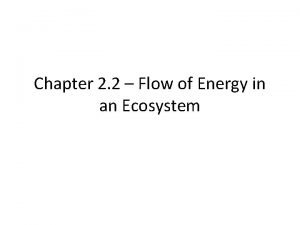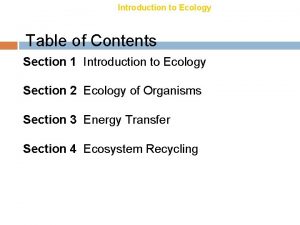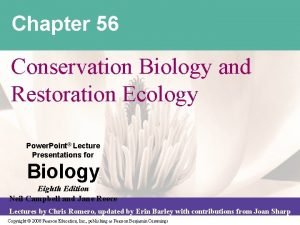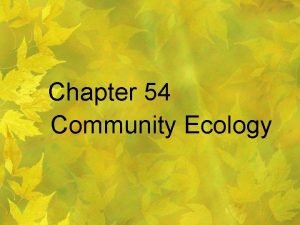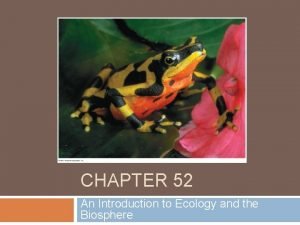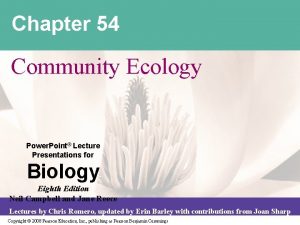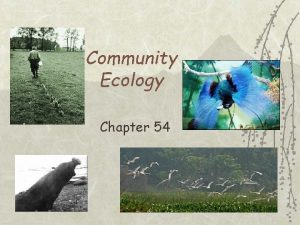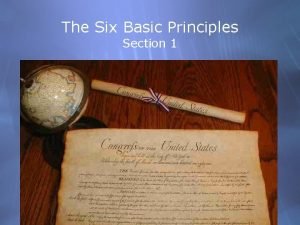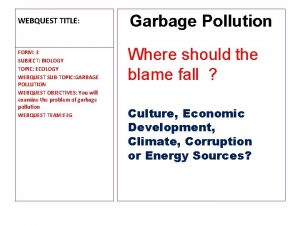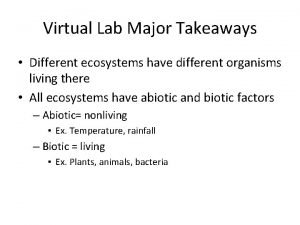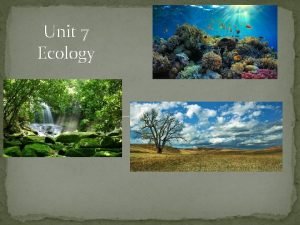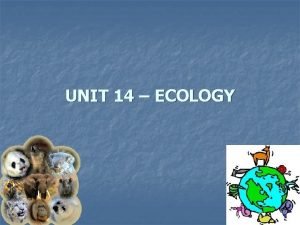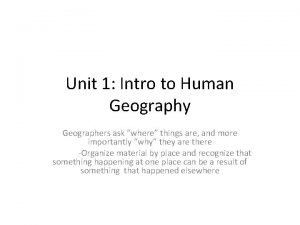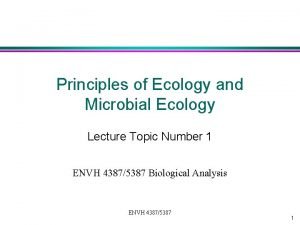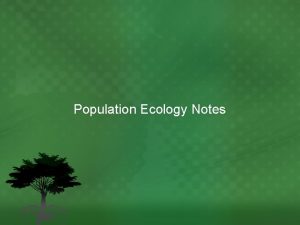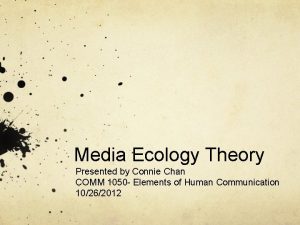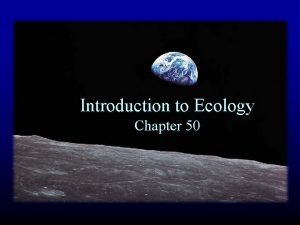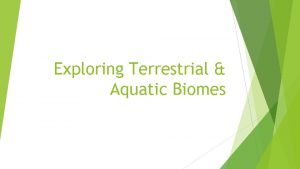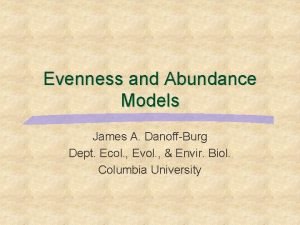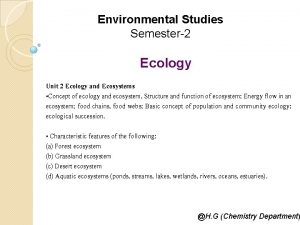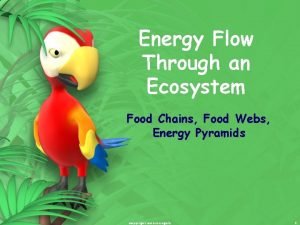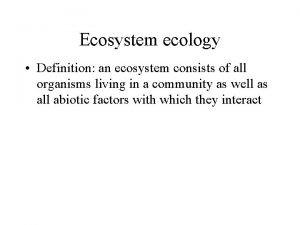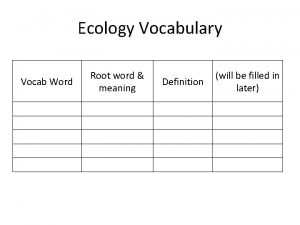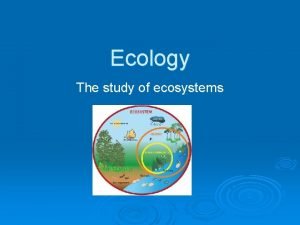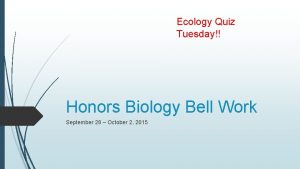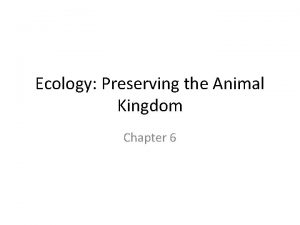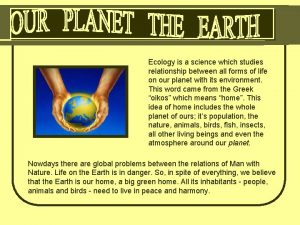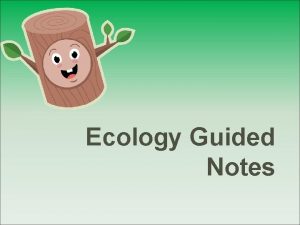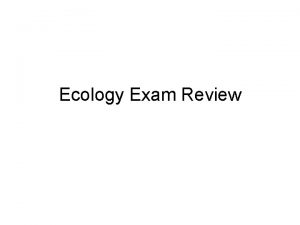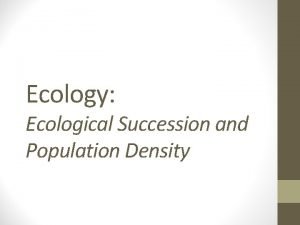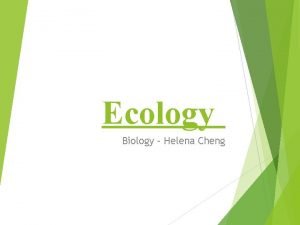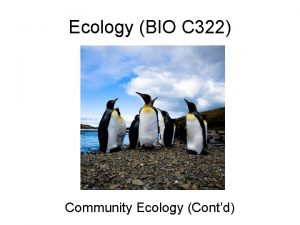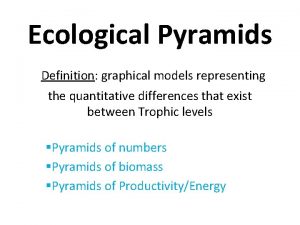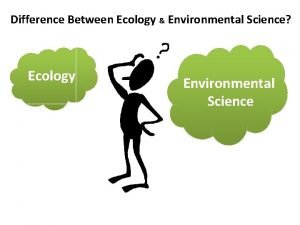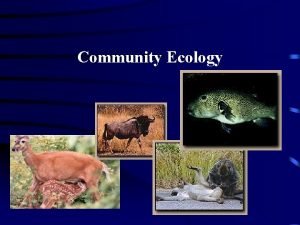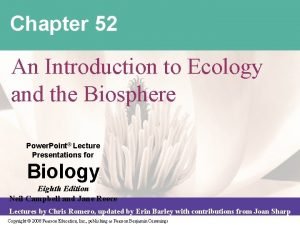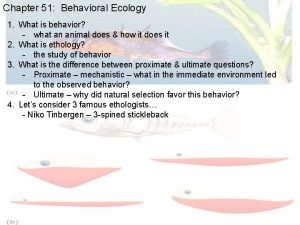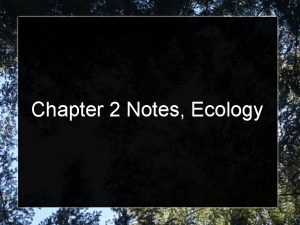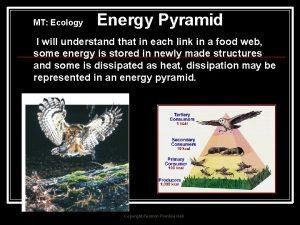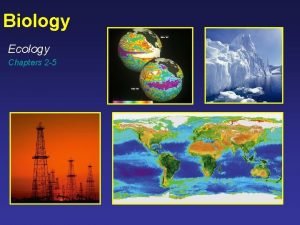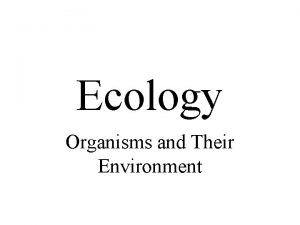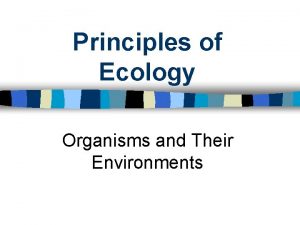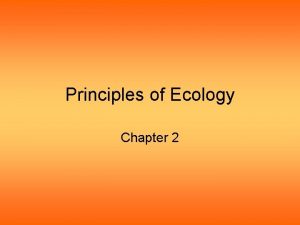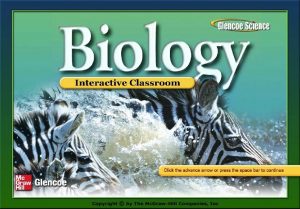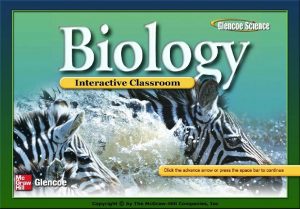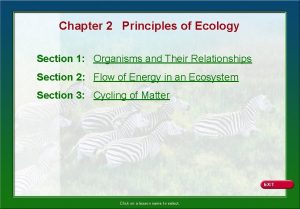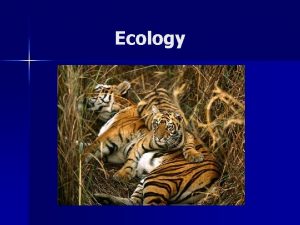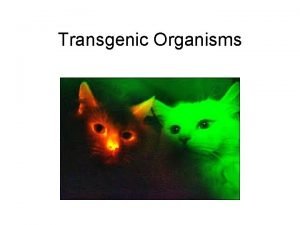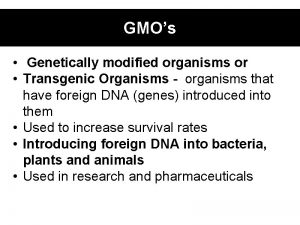Chapter 2 Principles of Ecology Section 1 Organisms

























































































- Slides: 89


Chapter 2 Principles of Ecology Section 1: Organisms and Their Relationships Section 2: Flow of Energy in an Ecosystem Section 3: Cycling of Matter Click on a lesson name to select.

1. Define Ecology…(is the study of what? ) Click on a lesson name to select.

Chapter 2 Principles of Ecology 2. 1 Organisms and Their Relationships Ecology § Scientific discipline in which the relationships among living organisms and the interaction the organisms have with their environments are studied § Org -to- org interactions & § Org –to- environment (rocks, water, etc) interactions § Ecologists observe, experiment, and model using a variety of tools and methods.

Chapter 2 Principles of Ecology 2. 1 Organisms and Their Relationships The Biosphere: Portion of earth that supports life § A thin layer around Earth § Extends several kilometers above the Earth’s surface § Extends several kilometers below the ocean’s surface

Chapter 2 Principles of Ecology 2. 1 Organisms and Their Relationships The Biosphere

2. List 2 Biotic factors and 2 Abiotic factors of the KMHS property ecosystem: A. Biotic B. Abiotic

Chapter 2 Principles of Ecology 2. 1 Organisms and Their Relationships Biotic Factors § Living factors in an organism’s environment Abiotic Factors § Nonliving factors in an organism’s environment: soil, water temp, light availability § Organisms adapt to survive in the abiotic factors present in their natural environment.

3. Put the levels of organization for organisms on Earth in order from most inclusive to least:

Chapter 2 Principles of Ecology 2. 1 Organisms and Their Relationships Levels of Organization § Levels increase in complexity as the numbers and interactions between organisms increase. § organism § population § biological community § ecosystem § biome § biosphere

7. Define population & give an ex. :

Chapter 2 Principles of Ecology 2. 1 Organisms and Their Relationships § The lowest level of organization is the individual organism itself. § Organisms of a single species that share the same geographic location at the same time make up a population. § A biological community is a group of interacting populations that occupy the same geographic area at the same time.

Chapter 2 Principles of Ecology 2. 1 Organisms and Their Relationships § An ecosystem is a biological community and all of the abiotic factors that affect it. § A biome is a large group of ecosystems that share the same climate and have similar types of communities.

4. Matching ____habitat ____niche ____competition ____predation

Chapter 2 Principles of Ecology 2. 1 Organisms and Their Relationships Ecosystem Interactions § A habitat is an area where an organism lives. § A niche is the role or position that an organism has in its environment.

Chapter 2 Principles of Ecology 2. 1 Organisms and Their Relationships Community Interactions § Competition § Occurs when more than one organism uses a resource at the same time § Predation § Many species get their food by eating other organisms.

5. Define Symbiosis 6. Describe what each type of symbiosis means and provide an example: a. Mutualism b. Commensalism c. Parasitism

Chapter 2 Principles of Ecology 2. 1 Organisms and Their Relationships Symbiotic Relationships § A close, prolonged association between two or more different organisms of different species § Mutualism § Commensalism § Parasitism

§ Mutualism: both org’s benefit (+, +) Ex. Gut flora Ex lichens

§ Commensalism: one benifts, other not affected (+, neutral)

§ Parasitism: one benefits, one harmed (+, -)

Prod 1: Work in groups of 1 -3 to make a sculpture garden (3 D models on paper path called “Walk of Symbiosis” Where you have sculpture to represent each type of symbiosis. Prod 2: Individual assignment. Explain the levels of organization (p. 37) through a product of your choice from the list I gave you. -Biosphere -biome -ecosystem -community -population -organism


8. Create a Venn diagram for Autotrophs and Heterotrophs

Chapter 2 Principles of Ecology 2. 2 Flow of Energy in an Ecosystem § Autotrophs § Organism that collects energy from sunlight or inorganic substances to produce food § Heterotrophs § Organism that gets it energy requirements by consuming other organisms A lynx is a heterotroph.

Chapter 2 Principles of Ecology 2. 2 Flow of Energy in an Ecosystem § Detritivores eat fragments of dead matter in an ecosystem, and return nutrients to the soil, air, and water where the nutrients can be reused by organisms. Fungus

Chapter 2 Principles of Ecology 2. 2 Flow of Energy in an Ecosystem Models of Energy Flow § Food chains and food webs model the energy flow through an ecosystem. § Each step in a food chain or food web is called a trophic level.

9. Make a food chain for a typical MN corn field in summer.

Chapter 2 Principles of Ecology 2. 2 Flow of Energy in an Ecosystem Food Chains § A food chain is a simple model that shows how energy flows through an ecosystem.


Chapter 2 Principles of Ecology 2. 2 Flow of Energy in an Ecosystem Food Webs § A food web is a model representing the many interconnected food chains and pathways in which energy flows through a group of organisms.

10. Make a food web for an ecosystem that includes: fungi, snakes, rabbits, grass, mountain lions, mice, shrubs, seed eating birds, trees, hawks, bacteria, deer. Use arrows to represent the flow of energy. Indicate trophic levels (decomposers, autotrophs, heterotrophs). -don’t need to write this one out if you study your assignment for today (same problem)


11. Draw 3 ecological pyramids, one each for energy, biomass, and numbers

Chapter 2 Principles of Ecology 2. 2 Flow of Energy in an Ecosystem Ecological Pyramids § A diagram that can show the relative amounts of energy, biomass, or numbers of organisms at each trophic level in an organism


Prod: MN Ecosystem Food Web -Make a food web for a typical MN Ecosystem (deciduous forest, boreal forest, grassland, lake or river, urban) -50 organisms min -Draw organisms with colored pencil and write common and scientific name underneath each -You should organize your food web like we discussed in class -3 rd level carnivores on the top/ producers on bottom -Arrows show who eats who

12. Explain why it is important that nutrients cycle in the environment:

Chapter 2 Principles of Ecology 2. 3 Cycling of Matter Cycles in the Biosphere § Energy is transformed into usable forms to support the functions of an ecosystem. § The cycling of nutrients in the biosphere involves both matter in living organisms and physical processes found in the environment such as weathering.

13. Detail one of the nutrient cycles in a labelled sketch (I will pick either water, Carbon, Nitrogen, or phosphorous)

Chapter 2 Principles of Ecology 2. 3 Cycling of Matter The Water Cycle


Chapter 2 Principles of Ecology 2. 3 Cycling of Matter § Approximately 90 percent of water vapor evaporates from oceans, lakes, and rivers; 10 percent evaporates from the surface of plants through a process called transpiration. § Freshwater constitutes only about 3 percent of all water on Earth. § About 69 percent of all freshwater is found in ice caps and glaciers.

Chapter 2 Principles of Ecology 2. 3 Cycling of Matter The Carbon Cycle


Chapter 2 Principles of Ecology 2. 3 Cycling of Matter § Carbon and oxygen often make up molecules essential for life. § Carbon and oxygen recycle relatively quickly through living organisms.

Chapter 2 Principles of Ecology 2. 3 Cycling of Matter Long-term Cycle § Organic matter converted to peat, coal, oil, or gas deposits (carbon) § Calcium carbonate (carbon and oxygen) Short-term Cycle § Burning fossil fuels (carbon)

Chapter 2 Principles of Ecology 2. 3 Cycling of Matter The Nitrogen Cycle § The capture and conversion of nitrogen into a form that is useable by plants is called nitrogen fixation.

14. Explain the crucial role played by Rhizobium bacteria on earth

Rhizobium bacteria

Chapter 2 Principles of Ecology 2. 3 Cycling of Matter § Nitrogen enters the food web when plants absorb nitrogen compounds from soil. § Consumers get nitrogen by eating plants or animals that contain nitrogen.

Chapter 2 Principles of Ecology 2. 3 Cycling of Matter § Nitrogen is returned to the soil in several ways: § Animals urinate. § Organisms die. § Organisms convert ammonia into nitrogen compounds. § Denitrification

Chapter 2 Principles of Ecology 2. 3 Cycling of Matter The Phosphorus Cycle


Chapter 2 Principles of Ecology 2. 3 Cycling of Matter Short-term Cycle § Phosphorus is cycled from the soil to producers and then from the producers to consumers. Long-term Cycle § Weathering or erosion of rocks that contain phosphorus slowly adds phosphorus to the cycle.

Water testing lab: Test the following samples of water: -Kasson, Mantorville, PI, Roch, rural well N of Mv for the following (each group will test all water samples for only one of these): 1. p. H and density 2. Dissolved O 2 3. Phosphate 4. Nitrate 5. Chloride Type up a lab report with data table and graph(s) that analyzes/ compares all water samples.

Product of the day: Horror story: “The Day the Rhizobium Died!” Why did they die? What would happen due to their loss? No drawings required! (Notebook paper ok)

Chapter 2 Principles of Ecology Chapter Resource Menu Chapter Diagnostic Questions Formative Test Questions Chapter Assessment Questions Standardized Test Practice biologygmh. com Glencoe Biology Transparencies Image Bank Vocabulary Animation Click on a hyperlink to view the corresponding lesson.

Chapter 2 Principles of Ecology Chapter Diagnostic Questions The act of one organism consuming another organism for food is _______. A. predation B. parasitism C. commensalism D. mutualism

Chapter 2 Principles of Ecology Chapter Diagnostic Questions Identify how energy flows through an ecosystem in a typical food chain. A. from an autotroph to a heterotroph B. from a heterotroph to an autotroph C. from a carnivore to an herbivore D. from an omnivore to an herbivore

Chapter 2 Principles of Ecology Chapter Diagnostic Questions What is a chemical substance that an organism must obtain from its environment to survive? A. biomass B. energy C. matter D. nutrient

Chapter 2 Principles of Ecology 2. 1 Formative Questions Which are biotic factors in a forest environment? A. plants and microscopic organisms living in the soil B. p. H and salt concentration of the soil C. sunlight, soil type and soil nutrients D. temperature, air currents and rainfall

Chapter 2 Principles of Ecology 2. 1 Formative Questions What is the name for a group of interacting populations that occupy the same area at the same time? A. ecosystem B. habitat C. biological community D. biotic collection

Chapter 2 Principles of Ecology 2. 1 Formative Questions Which defines habitat? A. all of the biotic factors in an ecosystem B. an area where an organism lives C. an area in which various species interact D. the role or position that an organism has

Chapter 2 Principles of Ecology 2. 2 Formative Questions What type of organism is the foundation of all ecosystems? A. autotroph B. herbivore C. heterotroph D. decomposer

Chapter 2 Principles of Ecology 2. 2 Formative Questions How do detritivores obtain their energy in an ecosystem? A. They feed on fragments of dead plants and animals. B. They feed on organisms by releasing digestive enzymes. C. They get energy from inorganic to make food. substances D. They use chlorophyll to capture energy the sun. from

Chapter 2 Principles of Ecology 2. 2 Formative Questions Which type of organism exists at all trophic levels except the first trophic level? A. carnivores B. herbivores C. autotrophs D. heterotrophs

Chapter 2 Principles of Ecology 2. 3 Formative Questions What type of organism returns nutrients to an ecosystem? A. decomposer B. primary producer C. secondary producer D. top level consumer

Chapter 2 Principles of Ecology 2. 3 Formative Questions What type of scientist studies water found underground, in the atmosphere, and on the surface of the earth? A. biochemist B. ecologist C. geologist D. hydrologist

Chapter 2 Principles of Ecology 2. 3 Formative Questions Which biogeochemical cycle involves evaporation, transpiration, precipitation and runoff? A. carbon cycle B. nitrogen cycle C. phosphorus cycle D. water cycle

Chapter 2 Principles of Ecology 2. 3 Formative Questions Which process in this cycle converts carbon dioxide and water into carbohydrates?

Chapter 2 Principles of Ecology 2. 3 Formative Questions A. photosynthesis B. respiration C. combustion of fossil fuels D. deposition of dead material

Chapter 2 Principles of Ecology Chapter Assessment Questions Use the diagram to compare and contrast biotic and abiotic factors. Give examples of each.

Chapter 2 Principles of Ecology Chapter Assessment Questions Answer: Biotic factors include the living factors in an organism’s environment, such as animals, reptiles, plants, and microscopic organisms. Abiotic factors are the nonliving factors, such as water temperature, rainfall, soil, and available nutrients.

Chapter 2 Principles of Ecology Chapter Assessment Questions Use the image below to explain how decomposers supply phosphorus to soil, groundwater, oceans, lakes, ponds, and rivers.

Chapter 2 Principles of Ecology Chapter Assessment Questions Answer: All organisms contain phosphorus. When organisms die or produce waste products, decomposers return the phosphorus to the soil where it can be used again.

Chapter 2 Principles of Ecology Chapter Assessment Questions The diagram shows how carbon cycles through the environment. Describe how photosynthesis is involved in the carbon cycle.

Chapter 2 Principles of Ecology Chapter Assessment Questions Answer: During photosynthesis, green plants and algae convert carbon dioxide and water to carbohydrates and release oxygen into the air. The plants use the carbohydrates for energy. Carbon dioxide is released back into the air through cellular respiration.

Chapter 2 Principles of Ecology Standardized Test Practice In what type of activity would you most expect an ecologist to be involved? A. identifying and classifying various species insects in an ecosystem of B. locating fossils of distinct species of turtles ina geographical area C. observing the relationships that have with other species in their environment woodpeckers D. studying the internal organs of a seal to how it survives in its environment learn

Chapter 2 Principles of Ecology Standardized Test Practice Certain types of tropical orchids use trees for support in order to grow higher and obtain more light. This neither harms nor benefits the tree. What type of symbiotic relationship is this? A. commensalism B. competition C. mutualism D. parasitism

Chapter 2 Principles of Ecology Standardized Test Practice True or False If an ecologist finds that the long-tailed weasels have disappeared from the desert community, she should conclude that there will be a decrease in the population of coyotes.

Chapter 2 Principles of Ecology Standardized Test Practice Why is this mouse classified as an omnivore? A. It consumes grasshoppers. B. It is consumed by snakes. C. It consumes both grasshoppers and snakes. D. It is a third-level consumer.

Chapter 2 Principles of Ecology Standardized Test Practice Which process returns nitrogen to the food web? A. decomposition B. denitrification C. nitrification D. nitrogen fixation

Chapter 2 Principles of Ecology Glencoe Biology Transparencies

Chapter 2 Principles of Ecology Image Bank

Chapter 2 Principles of Ecology Vocabulary Section 1 ecology habitat biosphere biotic factor abiotic factor population biological community ecosystem niche predation symbiosis mutualism commensalism parasitism biome

Chapter 2 Principles of Ecology Vocabulary Section 2 autotroph food chain heterotroph herbivore carnivore omnivore detritivore trophic level food web biomass

Chapter 2 Principles of Ecology Vocabulary Section 3 matter nutrient biogeochemical cycle nitrogen fixation denitrification

Chapter 2 Principles of Ecology Animation Visualizing Levels of Organization Desert Community Food Web The Water Cycle The Carbon Cycle The Nitrogen Cycle The Phosphorus Cycle
 Principles of ecology chapter 2 answer key
Principles of ecology chapter 2 answer key Section 1 organisms and their relationships
Section 1 organisms and their relationships Principles of ecology chapter 2
Principles of ecology chapter 2 Chapter 2 section 1 organisms and their relationships
Chapter 2 section 1 organisms and their relationships Principles of ecology section 2 flow of energy
Principles of ecology section 2 flow of energy Organisms ecology
Organisms ecology Competitive interaction
Competitive interaction Single celled and multicellular organisms
Single celled and multicellular organisms Study guide chapter 3 section 1 community ecology
Study guide chapter 3 section 1 community ecology Chapter 4 population ecology section 1 population dynamics
Chapter 4 population ecology section 1 population dynamics Chapter 4 population ecology section 1 population dynamics
Chapter 4 population ecology section 1 population dynamics Chapter 8 section 1 how organisms obtain energy answer key
Chapter 8 section 1 how organisms obtain energy answer key Chapter 8 section 1 how organisms obtain energy answer key
Chapter 8 section 1 how organisms obtain energy answer key Chapter 8 section 1 how organisms obtain energy
Chapter 8 section 1 how organisms obtain energy Chapter 8 section 1 how organisms obtain energy
Chapter 8 section 1 how organisms obtain energy Chapter 2 section 1 organisms and their relationships
Chapter 2 section 1 organisms and their relationships Principles of ecology 2 flow of energy in an ecosystem
Principles of ecology 2 flow of energy in an ecosystem Section 18-1 introduction to ecology worksheet answers
Section 18-1 introduction to ecology worksheet answers Section 1 population dynamics
Section 1 population dynamics Population ecology section 1 population dynamics
Population ecology section 1 population dynamics Chapter 52: an introduction to ecology and the biosphere
Chapter 52: an introduction to ecology and the biosphere Chapter 56 conservation biology and restoration ecology
Chapter 56 conservation biology and restoration ecology Phosphorus cycle pearson education
Phosphorus cycle pearson education Chapter 54 community ecology
Chapter 54 community ecology Chapter 53 population ecology
Chapter 53 population ecology Chapter 52 an introduction to ecology and the biosphere
Chapter 52 an introduction to ecology and the biosphere Evolution and community ecology guided notes
Evolution and community ecology guided notes Equilibrial life history
Equilibrial life history Ecology
Ecology Biological disturbance
Biological disturbance Chapter 53 population ecology
Chapter 53 population ecology Chapter 55 ecosystems and restoration ecology
Chapter 55 ecosystems and restoration ecology Chapter 5 evolution and community ecology
Chapter 5 evolution and community ecology Ecosystems interactions
Ecosystems interactions Section 1 population dynamics answer key
Section 1 population dynamics answer key Chapter 53 population ecology
Chapter 53 population ecology Chapter 54 community ecology
Chapter 54 community ecology Concept mapping chapter 10 meiosis 1 and meiosis 2
Concept mapping chapter 10 meiosis 1 and meiosis 2 27 amendments
27 amendments Ecology webquest answers
Ecology webquest answers Ecology virtual lab
Ecology virtual lab Unit 7 ecology
Unit 7 ecology Parasitism
Parasitism Cultural ecology ap human geography
Cultural ecology ap human geography The geometric arrangement of objects in space
The geometric arrangement of objects in space Difference between ecology and environment
Difference between ecology and environment Whats a climax community
Whats a climax community Stable community
Stable community Whats a niche
Whats a niche Clumped dispersion
Clumped dispersion Biotic potential
Biotic potential The concept of population
The concept of population Gendina
Gendina What is media ecology
What is media ecology Tropical grassland
Tropical grassland Folk housing
Folk housing Organismal ecology
Organismal ecology Organismal ecology
Organismal ecology Rank abundance curve excel
Rank abundance curve excel Difference between ecosystem and ecology
Difference between ecosystem and ecology Food chain in garden ecosystem
Food chain in garden ecosystem An ecosystem consists of
An ecosystem consists of Building vocabulary: word roots - ecology
Building vocabulary: word roots - ecology Ecology definition
Ecology definition Levels of organization in ecology
Levels of organization in ecology Ecology study guide
Ecology study guide Honors biology ecology test
Honors biology ecology test Ecology preserving the animal kingdom
Ecology preserving the animal kingdom Ecology is a science which studies the relationship between
Ecology is a science which studies the relationship between Ecology guided notes
Ecology guided notes Which phrase best describes the focus of ecology?
Which phrase best describes the focus of ecology? Ecological disturbance
Ecological disturbance Detritivore definition ecology
Detritivore definition ecology Example of neutralism
Example of neutralism Population vs community ecology
Population vs community ecology A student is studying the ecology of a playa lake
A student is studying the ecology of a playa lake Pyramid of biomass
Pyramid of biomass Ecological pyramid definition
Ecological pyramid definition Ecology and environment difference
Ecology and environment difference Concept 3 population ecology
Concept 3 population ecology Kinesis ecology
Kinesis ecology Community ecology
Community ecology K selection r selection
K selection r selection Top down model ecology
Top down model ecology Ecology deals with
Ecology deals with Kinesis ecology
Kinesis ecology What is ecology
What is ecology Energy pyramid example
Energy pyramid example Biotic potential
Biotic potential Proximate and ultimate behavior examples
Proximate and ultimate behavior examples











